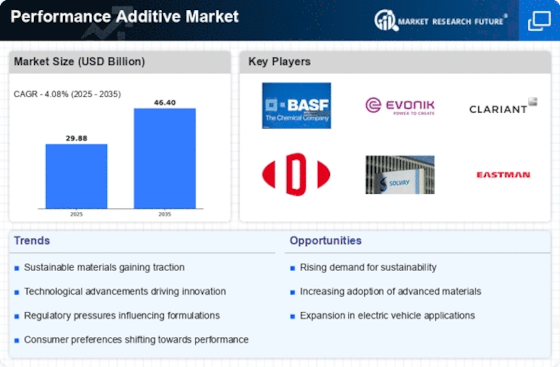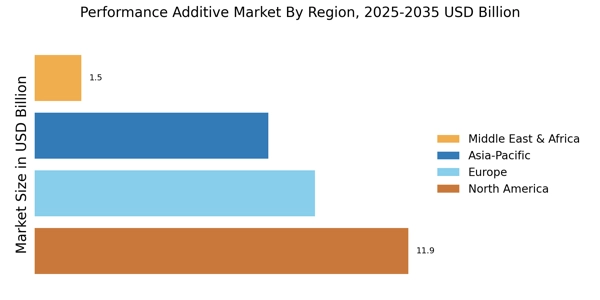Expansion of the Electronics Industry
The electronics industry is a key driver of the Performance Additive Market, as the demand for high-performance electronic components continues to rise. Additives that enhance electrical conductivity, thermal management, and flame retardancy are increasingly sought after in the production of electronic devices. With the proliferation of smart technologies and the Internet of Things (IoT), the need for reliable and efficient electronic components is paramount. The performance additive market within the electronics sector is expected to grow at a CAGR of approximately 5% over the next few years, reflecting the industry's commitment to innovation and performance enhancement.
Increasing Focus on Energy Efficiency
The Performance Additive Market is witnessing a growing emphasis on energy efficiency, particularly in sectors such as construction and automotive. Performance additives are being utilized to enhance the thermal insulation properties of materials, thereby reducing energy consumption in buildings and vehicles. For example, additives that improve the thermal stability of insulation materials are gaining traction as energy regulations become more stringent. This trend is likely to drive the demand for performance additives, with projections indicating a potential market growth of 4.5% annually as industries strive to meet energy efficiency standards and reduce their carbon footprint.
Growth in the Coatings and Paints Sector
The coatings and paints sector is a significant contributor to the Performance Additive Market, as manufacturers seek to enhance the performance characteristics of their products. Additives such as anti-corrosive agents, UV stabilizers, and rheology modifiers are increasingly utilized to improve the longevity and aesthetic appeal of coatings. The market for performance additives in this sector is expected to expand, driven by the rising demand for environmentally friendly and high-performance coatings. In 2024, the coatings segment is anticipated to account for over 30% of the total performance additive market, indicating a robust growth trajectory fueled by innovation and sustainability.
Rising Demand for High-Performance Materials
The Performance Additive Market is experiencing a notable increase in demand for high-performance materials across various sectors, including automotive, aerospace, and electronics. This trend is driven by the need for enhanced durability, efficiency, and lightweight solutions. For instance, the automotive sector is increasingly adopting advanced composites and polymers that require performance additives to improve mechanical properties and thermal stability. As a result, the market for performance additives is projected to grow at a compound annual growth rate (CAGR) of approximately 5.5% over the next few years, reflecting the industry's shift towards innovative materials that meet stringent performance criteria.
Technological Innovations in Additive Manufacturing
Technological advancements in additive manufacturing are reshaping the Performance Additive Market. Innovations such as 3D printing and advanced polymer formulations are enabling the production of complex geometries and customized solutions. Performance additives play a crucial role in enhancing the properties of materials used in additive manufacturing, such as improving layer adhesion and reducing warping. As industries increasingly adopt 3D printing technologies, the demand for specialized performance additives is likely to rise. This shift is expected to contribute to a market growth rate of around 6% annually, as manufacturers seek to leverage the benefits of additive manufacturing for rapid prototyping and production.


















Leave a Comment